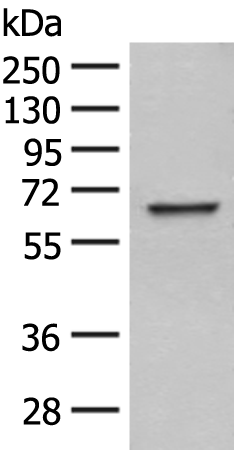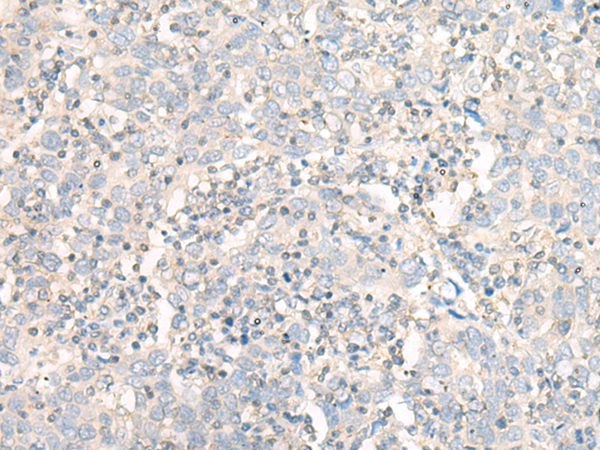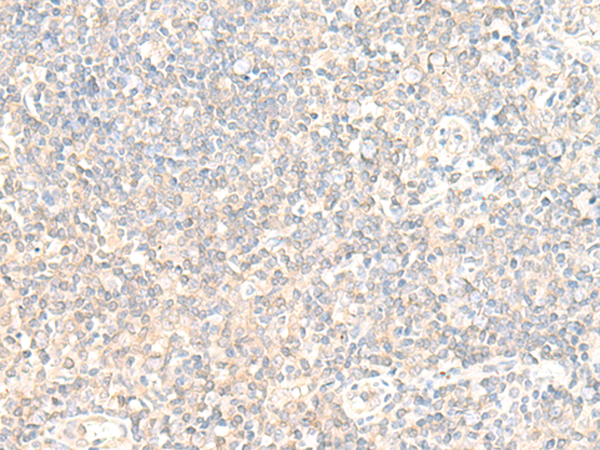


| WB | 咨询技术 | Human,Mouse,Rat |
| IF | 咨询技术 | Human,Mouse,Rat |
| IHC | 1/30-1/150 | Human,Mouse,Rat |
| ICC | 技术咨询 | Human,Mouse,Rat |
| FCM | 咨询技术 | Human,Mouse,Rat |
| Elisa | 1/5000-1/10000 | Human,Mouse,Rat |
| Aliases | AIP1; NORI-1; HEL-S-52 |
| WB Predicted band size | 66 kDa |
| Host/Isotype | Rabbit IgG |
| Antibody Type | Primary antibody |
| Storage | Store at 4°C short term. Aliquot and store at -20°C long term. Avoid freeze/thaw cycles. |
| Species Reactivity | Human, Mouse, Rat |
| Immunogen | Fusion protein of human WDR1 |
| Formulation | Purified antibody in PBS with 0.05% sodium azide and 50% glycerol. |
+ +
以下是关于WDR1抗体的3篇参考文献,内容涵盖其功能研究及实验应用:
---
1. **文献名称**:*WDR1 is a novel oncogenic gene in glioblastoma involved in tumor migration, invasion, and apoptosis through the Ras signaling pathway*
**作者**:Li Y, et al.
**摘要**:该研究利用WDR1抗体通过Western blot和免疫组化分析,发现WDR1在胶质母细胞瘤中高表达,并通过调控Ras信号通路促进肿瘤迁移和侵袭,同时抑制细胞凋亡。
2. **文献名称**:*Structural and functional analysis of the role of WDR1 in cofilin-mediated actin filament severing*
**作者**:Nakashima K, et al.
**摘要**:研究者通过免疫荧光技术结合WDR1抗体,揭示了WDR1与cofilin蛋白协同调节肌动蛋白丝切割的分子机制,阐明了其在细胞骨架重塑中的关键作用。
3. **文献名称**:*Deficiency of WDR1 leads to autoinflammatory diseases by impairing neutrophil apoptosis and clearance*
**作者**:Kahr WH, et al.
**摘要**:该研究使用WDR1抗体检测患者中性粒细胞中的蛋白表达,发现WDR1缺失导致细胞凋亡障碍和炎症因子异常释放,与自身炎症性疾病的发生密切相关。
---
以上文献均通过WDR1抗体进行蛋白定位或表达分析,探讨其在肿瘤、细胞动力学及免疫疾病中的功能。如需具体期刊信息或发表年份,可进一步补充关键词检索。
**Background of WDR1 Antibody**
The WDR1 (WD repeat domain 1) protein, also known as actin-interacting protein 1 (AIP1), is a conserved regulator of actin cytoskeleton dynamics. It facilitates cofilin-mediated actin filament disassembly by promoting filament severing and debranching, playing critical roles in cell migration, cytokinesis, and tissue development. WDR1 interacts with cofilin and enhances its activity, making it essential for maintaining cellular homeostasis and responding to mechanical or pathological stress.
Antibodies targeting WDR1 are vital tools for studying its expression, localization, and function in diverse biological contexts. They are widely used in techniques like Western blotting, immunofluorescence, and immunohistochemistry to investigate WDR1's involvement in diseases, including immunodeficiencies, cancer metastasis, and neurodegenerative disorders. For instance, WDR1 mutations are linked to autoinflammatory syndromes and neutrophil dysfunction, highlighting its immunological relevance.
Researchers also utilize WDR1 antibodies to explore its role in developmental processes, such as cardiac morphogenesis, and its interplay with signaling pathways like TGF-β. These antibodies are often validated for specificity across species (human, mouse, rat) and sample types (tissues, cultured cells), ensuring reliability in experimental models. By enabling precise detection of WDR1. these reagents contribute to understanding cytoskeletal regulation and developing therapeutic strategies targeting actin-related pathologies.
×